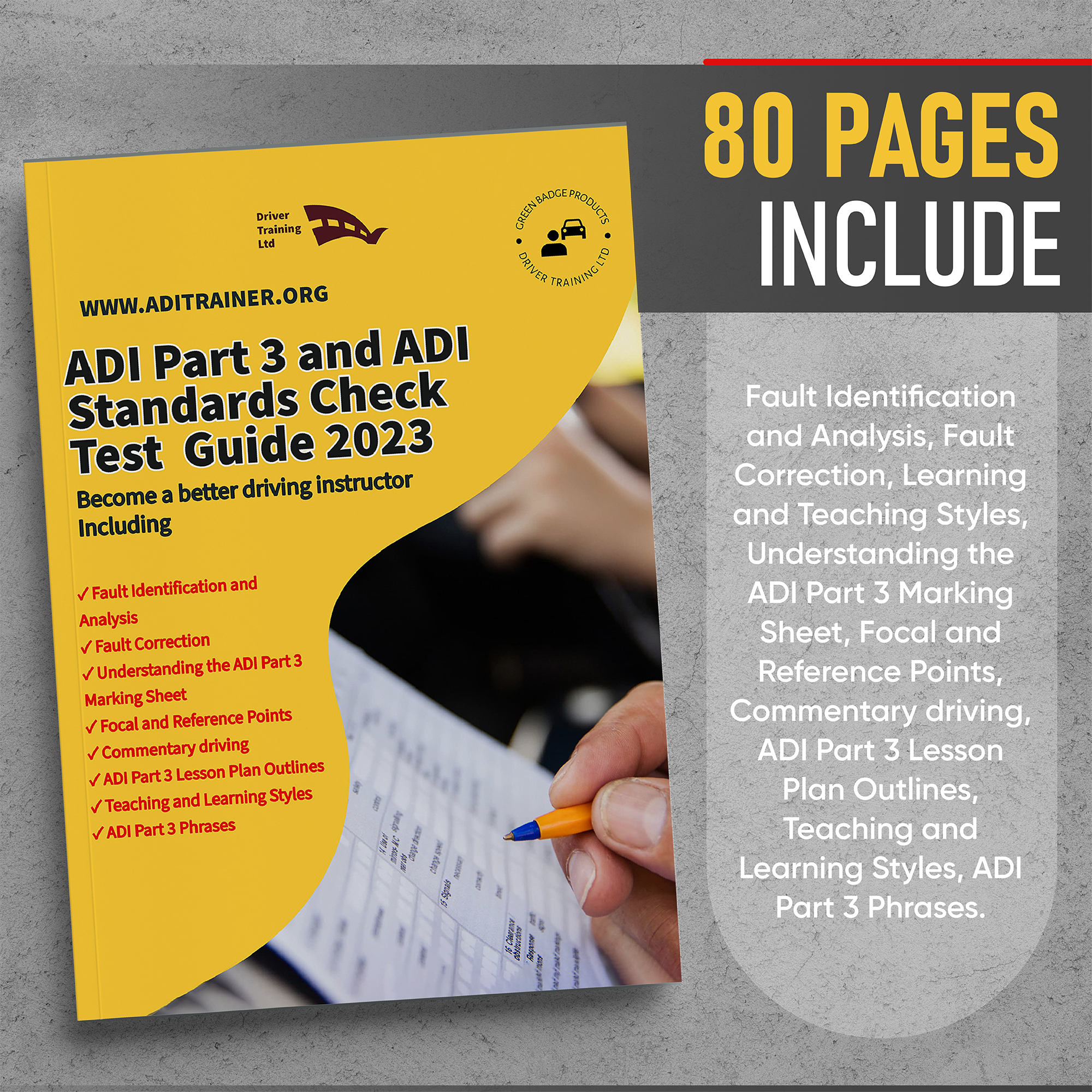Top 5 Reasons ADI's Fail Their Check Test
Top 5 Reasons ADIs Fail Their Check Test
TOP 5 REASONS FOR FAILING ADI STANDARDS CHECK
A while back the dvsa in their dispatch magazine gave the top five reasons for driving instructors failing the ADI standards check test. In this article we're going to break those reasons down, to help you understand how you can avoid making the same mistakes.
Top 5 reasons ADIs fail their standards check
During your standards check, your examiner will be looking for evidence that you meet the national standards for driver and rider training.
You’ll be marked on 17 areas of competence that are grouped into 3 categories:
lesson planning
risk management
teaching and learning skills
Analysing standards check data - this year, we analysed data from over 2,000 standards checks.
Here are The top 5 reasons for Failing the adi standards check


Reason for Failing The ADI standards check
Our latest analysis shows the top 5 areas where instructors fail to demonstrate competence are where they haven’t:
1- adapted the lesson plan, when appropriate, to help the pupil work towards their learning goals
2 - taught the lesson in a style suited to the pupil’s learning style and current ability
3 - encouraged the pupil to analyse problems and take responsibility for their learning
4 - given the pupil appropriate and timely feedback during the session
5 - given enough feedback to help the pupil understand any potentially safety-critical incidents
The ADI did not adapt the lesson plan, when appropriate, to help the pupil work towards their learning goals
So let’s break that list down to help us understand what was meant
1 -The ADI did not adapt the lesson plan, when appropriate, to help the pupil work towards their learning goals
You need to show you can adapt your lesson plan, where appropriate, to help your pupil work towards their learning goals.
You shouldn’t stick to a planned lesson - because the needs of your pupil might change throughout the lesson and it’s important you can adapt to that.

EXAMPLE
The lesson plan for the ADI Standards check is roundabouts – Specifically finding/Judging a safe gap and staying in the lane around roundabouts
However, because of the pressure of the day and the pupil wrongly thinking that the examiner is watching them and not you as the driving instructor, the pupil keeps stalling.
CORRECT ACTION
At this point you should pull the student up at the side of the road and have a quick chat about how they are feeling. Are they nervous or worried? Because they don’t normally have a problem with clutch control? Is it because of driving with the extra weight in the car, which we haven’t done before?
Make light of the situation – Is it because of the person in the back? Are they making you nervous? They’re making me nervous! Then smile or laugh and say but there’s no need they are not watching you its not your driving test remember.
CHANGE THE PLAN
I tell you what chris, a big part of being able to pick safe gaps on roundabouts, is the ability to move off quickly and safely to get into those gaps. So we need to be concentrating on the gaps in the traffic, rather than worrying if we are going to stall or not.
So how about, for the next short while, we put doing the roundabouts to one side and focus on our moving off with the extra person in the car? – Then when we feel more confident in doing that, we will go back to gaps on roundabouts, does that seem good to you?
Now you are helping the pupil to work on the right subject, so when you do roundabouts they are more confident and able to fully focus on what you are teaching them
Let us Help You understand the ADI Check Test
Each subject is comprehensively covered including understanding the marking sheet, fault identification, Fault Analysis and Pupil Reference Points. The thicker covers ensure durability and ease of use.
* Includes Detailed Instruction - Unlike other ADI Part 3 and ADI Standards Check Test Guides, ours provides a simple but comprehensive explanation of the aspects of taking the ADI Part 3 or the ADI Standards Check Test exam.
Including
✓Fault Identification and Analysis ✓Fault Correction ✓Learning and Teaching Styles ✓Understanding the ADI standards check Marking Sheet ✓Focal and Reference Points ✓Commentary driving ✓ADI standards check Lesson Plan Outlines ✓Teaching and Learning Styles ✓ADI standards check Phrases
GET YOURS FROM OUR EBAY STORE
GET YOURS FROM OUR AMAZON STORE


The ADI has not taught the lesson in a style suited to the pupil’s learning style and current ability
2 -The ADI has not taught the lesson in a style suited to the pupil’s learning style and current ability
You need to be able to show you can teach your pupil in a style that’s suited for them. This means using methods that work best for them.
Did you know that there are generally 4 main ways of learning – often summed up as VARK?
VARK stands for Visual, Auditory, Reading/Writing, and Kinesthetic. These represent the four primary sensory modalities through which people prefer to receive and process information.
Visual learners: Visual learners prefer to learn through visual aids such as diagrams, charts, and images. They understand information better when it is presented in a visual format.
Audio learners: Auditory learners prefer to learn through listening. They grasp information more effectively when it is presented verbally, such as through lectures, discussions, or audio recordings.
Reading/Writing learners: Reading/Writing learners prefer to learn through written words. They learn best by reading and writing, taking notes, and referring to written materials like textbooks or written instructions.
Kinesthetic learners: Kinesthetic learners prefer to learn through physical experiences and hands-on activities. They learn best by doing, touching, and engaging in activities that involve movement and manipulation of objects
EXAMPLE
Most people think in pictures – a picture paints a thousand words – So rather than wave your hands about trying to explain something to them – did you get your briefing folder out and show them a picture?
Or For example, when giving verbal directions, your pupil might find it easier if you referred to left and right as ‘my side’ or ‘your side’.
encouraged the pupil to analyse problems and take responsibility for their learning
3 - encouraged the pupil to analyse problems and take responsibility for their learning
Help them understand what Was wrong and why it was wrong- What could have been the potential outcomes and how they can avoid doing it again.
You should encourage your pupil to analyse problems and take responsibility for their learning. For example, if your pupil forgot to check their blind spot before pulling out, you might:
ask them if they know what they did wrong –

EXAMPLE
What do we need to check before moving off? – Mirrors
Mirrors and…..? – Oh blindspot
That’s right, yes and why do we need to check the blindspot? – In case there’s a vehicle, cyclist or pedestrian there.
That’s correct – But if there was, I’d know because I would hear them
This car we are in is Hybrid chris, how many times have you mentioned how quiet it is? – Oh Lots
Remember the video we showed you, of the e-scooters doing 80mph? – Oh yes
Could you hear them? – No, we couldn’t
So, if there is an e-bike or e-scooter, electric car or hybrid car like ours alongside us, will you hear it? – No!
If we did pull out and hit something, whose fault would it be? – Probably mine
So how can we stop that from happening? – Check my blindspot!

The ADI has not given the pupil appropriate and timely feedback during the session
4 - given the pupil appropriate and timely feedback during the session
It’s important you give your pupil appropriate and timely feedback rather than giving it all at the end of the lesson.
Break the lesson down into bite-size pieces – discuss things, how did they feel at that? Discuss what went well – NOT just when things go wrong.
Having regular discussions throughout the lesson helps your pupil understand what they might have done wrong.
The driving instructor has not given enough feedback to help the pupil understand any potentially safety-critical incidents
5 - The driving instructor has not given enough feedback to help the pupil understand any potentially safety-critical incidents
Another area instructors commonly fail on is not giving pupils enough feedback on any potentially dangerous situations.
As well as providing your pupil with timely and appropriate feedback, it’s important that if they make any serious or dangerous faults they know what they’ve done and why it’s dangerous.
This links closely with point 3.

EXAMPLE
A pupil does not stop at a closed junction, when emerging right, but drives out at around 10 mph looking just to the right.
The instructor merely says “You need to be sure it’s clear before pulling out”
Have they helped them understand that if there had been a vehicle coming from the right, they would have caused an accident?
Have they been helped to understand that they would have been the ones responsible for causing it?
Have they been made aware of the fact they did not look Right, Left and Right before moving out?
So if a vehicle had been coming from the left they would have pulled out into its path?
Have they been made aware of the fact that not only is doing that dangerous but would result in them instantly failing their driving test, so costing them a lot more money?